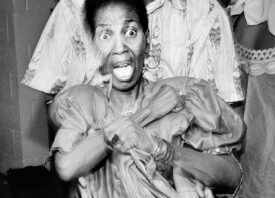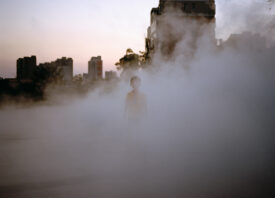Search this site
This Haitian Photographer Captures Marginalized Communities with Hyper-Realist Portraiture


Haitian photographer Zarita Zevallos takes a particular interest in identities, communities and their place in the world we live in today.
Through hyper-realist portraiture with a strong focus on colours, contrasts and shapes, the photographer captures her subjects in a way that makes them appear otherworldly, stately and powerful.
In an age where an increasing number of black artists are finally starting to have the spaces, resources and support to create works reflective of their own stories, the New York based photographer makes it a point to use her art to highlight unique individuals and how the community they live in interacts with them.
Originally from Haiti, the influence of her Haitian culture and heritage can be felt in Zarita’s work, especially in her series “PETWO”, in which she gives her visual interpretation of the Haitian voodoo cultures and traditions who, as Westernization increased in the country, have slowly been vilified and demonized.
When asked to explain a little bit the process of “PETWO”, Zarita says “The idea behind Petwo was to expose our prejudice and ‘miseducation’ of how we view ‘Voodoo’. I’ve noticed in many conversations how black people in general put Voodoo under a pejorative light; but when it comes to using the art form, meaning the tribal designs and clothing, only then it’s accepted and adopted. I hint on a lot of things for this series. PETWO, is a rite that reflects courage, strength, protection etc…, and the reason I use women is because our Black Haitian women represent exactly that and are excessively taken advantage of. We praise them in our artwork yet in reality, we dispose of them until we can make use of them again; just like our voodoo culture.
As for the painting in each woman’s face, Lost In The Island (MUA) and I agreed to have an exotic symbol that represented a deity in the PETWO rite, such as Erzuli Dantor, Simbi Andezo and Kalfou.”
Practices and behaviours embedded in the socio-cultural makeup of contemporary society is also something that is of interest to the photographer. In “Koktel”, Zarita directs her lens on men sharing their experiences navigating a world in which gender performance is expected from them at all times.
She says “Kòktèl”, the Haitian Creole word for cocktail, is an experimental photo series that explores the diversity of Black masculinity, as black men are made of many wonders. The colorful thread bending, crossing, and extending is used to signify the feeling of being trapped as well as the idea of building one’s identity.
At the time I was working on this concept, the President of the USA as well as the senate in Haiti were threatening the rights of the gay community and they did so successfully and inhumanly. It added more passion and purpose to my work in general. I still believe that art can change the world and push people to make a change as it once did.”
With this series, the photographer attempts to highlight the diversity and range that exists in masculinity and the way said masculinity is expressed. The subject’s complex relationships with their masculinity were represented by the photographer by colourful threads around their intentionally desaturated bodies. “The pictures were printed on paper and sown on. I learned different techniques of sewing from the internet and applied different patterns/designs on the pictures depending on the poses the model had taken. I then brought them back to photoshop, overlayed the thread onto the digital images and erased the parts I didn’t need.”
Aware of her inability to directly relate to these experiences, the photographer asked men of different walks of life to share their stories of struggle and trauma with this sociocultural issue that has impacted generations before them. From 72 years old straight men to queer men and transmen of colour, “Koktel” once again highlights the photographer’s drive and desire to celebrate the diversity of identities.
Issues of race and racial discrimination are also of interest to the photographer who, in her series “Imperium”, explores the strength and resilience of a black community who despite centuries of dehumanization, objectification and servitude, continue to thrive and a grow in a world that does not necessarily want them to. “Imperium is about thriving in a anti-black world that has and still is working hard to break us, individually and as a community. It’s about finding strength at the very root of our being; to grow and stand tall for ourselves in our skin. This skin they bash, denigrate, lied to us about, throw stones at. This protective envelope is our monument, our crown and although we find divine madness in it, we must embrace it in order to achieve freedom. We must protect our empire.” the photographer says to describe this particular body of work.
Much like her other series, “Imperium” is faithful to the photographer’s style, superposing what seems to look like debris and rubble on, once again, desaturated portraits taken of her subjects. To describe the process, Zarita says “Broken glass and dirt were used in this series. The glass represented a shattered soul, the pieces of us we try to hide in a society that didn’t accept us unless we conformed to their rules. The dirt and stones is how other races have tried to taint the truth about us, shattering the glass through which we see the reality. Blurring the lines of the truth, burying us under the pain and suffocating ourselves.”
The hyper-realist nature of Zarita’s work therefore allows her to tell the stories of these marginalized and discriminated groups in ways that still allows them to conserve their dignity and strength, in spite of the challenges they encounter daily.







All images © Zarita Zevallos



